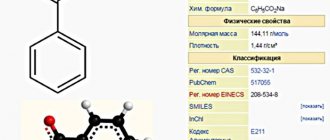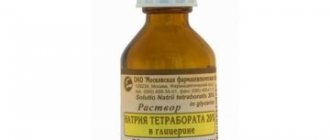Pharmacodynamics and pharmacokinetics
Sodium thiopental acts as a hypnotic and narcotic. It is used primarily for intravenous anesthesia . The drug also has some muscle relaxant and analgesic effects.
On the postsynaptic membrane of brain neurons, the drug prolongs the period of opening of γ-aminobutyric acid-dependent channels . It inhibits the excitatory effect of amino acids , prevents the conduction and spread of convulsive impulses throughout the brain, has anticonvulsant activity, and increases the threshold of neuronal excitability .
The drug promotes muscle relaxation by blocking polysynaptic reflexes and inhibiting conduction along interneurons of the spinal cord. In addition, the drug reduces metabolic processes in the brain and the brain's utilization of oxygen and glucose.
Acts as hypnotic , helps change the structure of sleep and speeds up falling asleep. Reduces the sensitivity of the respiratory center to carbon dioxide and depresses breathing. Sodium thiopental acts as cardiodepressant : it reduces stroke volume , blood pressure and cardiac output . The medicine increases the capacity of the venous system , the glomerular filtration and reduces hepatic blood flow .
Has a stimulating effect on the vagus nerve . May provoke laryngospasm and mucus production.
The effect of the drug becomes noticeable 40 seconds after intravenous administration , and after rectal administration - after 8-10 minutes. The effect of the drug is short-lived. After a single injection, anesthesia lasts 20-25 minutes. Awakening occurs without residual drowsiness .
With general anesthesia , there is a decrease or complete disappearance of tendon and corneal reflexes , a stationary or “floating” position of the eyeballs, a decrease in the depth of breathing, relaxation of the pharyngeal muscles, retraction of the tongue, and a decrease in blood pressure .
The analgesic effect ceases when the patient awakens. In case of repeated administration, the effect of the drug is prolonged.
When administered intravenously, the drug quickly reaches the brain, kidneys, adipose tissue, skeletal muscle and liver. The degree of binding to plasma is about 83%. The drug is able to penetrate the placental barrier and enter breast milk. It is broken down primarily in the liver. In this case, inactive metabolites . Some of it is inactivated in the brain and kidneys. The half-life of this drug is approximately 11 hours. Excreted mainly through the kidneys.
Pharmacological properties of the drug Thiopental sodium
A drug for non-inhalation anesthesia with a pronounced hypnotic and moderate analgesic effect. Anesthesia is achieved both by intravenous and rectal administration. Anesthesia can also be achieved by intramuscular injection of sodium thiopental, but this route is not usually used. With the correct dosage, induction of anesthesia occurs easily and quickly, agitation and vomiting are rare, external breathing remains sufficient, and there is no salivation. After a short anesthesia, a quick awakening occurs. The surgical stage of anesthesia is characterized by a decrease or disappearance of tendon or corneal reflexes, a slight narrowing or normal size of the pupils, immobility of the eyeballs or their floating movement, relaxation of the pharyngeal muscles with retraction of the tongue, a decrease in the depth of breathing and a decrease in blood pressure, especially in persons with hypertension. Even with deep anesthesia, relaxation of the abdominal wall muscles may be insufficient. The drug is quickly destroyed (mainly in the liver) and excreted from the body. When recovering from anesthesia, the analgesic effect ceases simultaneously with the patient's awakening. The duration of anesthesia after a single dose is 20–25 minutes.
Indications for use
The drug is used intravenously for anesthesia during short-term operations. In addition, among its indications are: status epilepticus , grand mal seizures, increased intracranial pressure . It is also used to prevent hypoxia during TBI and as an introductory and basic anesthesia in the case of balanced anesthesia with the use of muscle relaxants and analgesics .
Contraindications
This drug should not be used in case of hypersensitivity to its components, status asthmaticus , disorders of myocardial contractile function , shock and collaptoid conditions , myxedema , fever , porphyria , bronchial asthma , / kidney dysfunction , severe anemia , myasthenia , diabetes mellitus , severe exhaustion, collapse , Addison's disease , inflammatory diseases of the nasopharynx and pregnancy .
Side effects
The medicine may cause chills , arrhythmia , difficulty or complete stoppage of breathing, nausea, rectal irritation, drowsiness , rectal bleeding hypotension , laryngospasm , bronchospasm , vomiting, headache and heart failure . In addition, when using it, the following allergic reactions : urticaria , itching , skin rashes, anaphylactic shock .
Scopolamine as the main substance of truth
“Truth Serum” is based on scopolamine. It is an alkaloid obtained from plants of the nightshade family (Datura, nightshade, henbane, etc.) Scopolamine is a white powder, easily soluble in liquid.
When the drug is administered, patients' pupils dilate, heart rate increases, smooth muscles relax, and sweating decreases. Scopolamine also has a sedative and hypnotic effect. After its use, all people experience amnesia.
Instructions for use of Sodium Thiopental (Method and dosage)
The medicine should be injected into the vein slowly. Speed approximately 1 ml/min. Otherwise, the likelihood of collapse .
Instructions for use of Thiopental Sodium indicate that, as a rule, a 2-2.5% solution of the drug is used anesthesia Children, elderly patients and weakened patients are administered a 1% solution. It is prepared immediately before use using pure water for injection , otherwise after a few hours the medicine will no longer be suitable for administration.
To prepare a 5% solution, add 20 ml of water for injection . A 1.25% solution is prepared by dissolving 0.5 g of Sodium Thiopental in 40 ml of water. The solvent used is purified water, 5% glucose solution or physiological sodium chloride solution. The solvent is drawn into a syringe and poured into an ampoule with the drug, where everything is mixed until the medicine is completely dissolved. The finished solution must be completely transparent, otherwise it cannot be used.
For induction of anesthesia, 20-30 ml of a 2% solution is injected. The same dosage is administered when using Sodium Thiopental alone for minor short-term operations. As a rule, 2-3 ml of solution is first injected , and then the remaining amount is injected after 20-30 seconds.
A 5% solution is slowly injected in a dosage of 4-6 ml into the cubital vein . If sleep does not occur, is injected . In most cases, no more than 10-12 ml of the drug is needed anesthesia The dosage is adjusted depending on the effect of the drug.
To relieve seizures, the drug is administered intravenously at a dose of 75-125 mg for 10 minutes. If seizures develop in the case of local anesthesia , administration of 125-250 mg for 10 minutes is indicated.
In case of hypoxia , the drug is administered at a dosage of 1.5-3.5 mg/kg 60 seconds before temporary cessation of blood circulation.
Patients with renal dysfunction are prescribed 75% of the average dosage.
For children, the drug can be administered rectally . For this, a 5% solution is used. Dosage – 0.04-0.05 g per 1 year of the patient’s life (age from 3 to 7 years).
In children, the medicine is administered intravenously Dose – 3-5 mg/kg. Before inhalation anesthesia without previous premedication the following dosages are indicated:
- 1-12 years – 5-6 mg/kg is administered;
- 1-12 months – 5-8 mg/kg is administered;
- up to 1 month – 3-4 mg/kg is administered.
For general anesthesia, children weighing 30-50 kg are administered 4-5 mg/kg. Maintenance dosage is from 25 to 50 mg.
A single dosage for adult patients should not exceed 1 g.
In order to avoid respiratory depression, it is advisable to give the patient to breathe a mixture of oxygen and carbon dioxide during anesthesia . In case of respiratory and circulatory disorders, administration of Cordiamin , caffeine, Corazol intravenously or intramuscularly .
History of appearance
Sodium pentothal began its history in 1913. One doctor, delivering a baby at home, administered scopolamine to a patient. At that time, this substance was widely used as an anesthetic. After the birth, the doctor asked for a scale to weigh the baby, but the woman’s husband could not find it, and he shouted: “Where are these scales?”, to which the woman clearly replied that they were “in the kitchen, behind the picture,” despite the fact that was in a semi-conscious state. The obstetrician did not immediately understand what had happened, but when the man brought the scales and said that they were located exactly in the place that his wife had indicated, the doctor realized that the injected substance had such an effect. After the use of scopolamine, the development of other drugs began that could suppress the central nervous system and cause truthful answers to the questions posed.
Now in the arsenal of institutions that need to obtain the truth from those interrogated, there are the following “truthful” substances:
- scopolamine;
- sodium pentothal;
- mescaline;
- Anabasine and others.
After the Texas case, “truth drugs” began to be used when interrogating criminals. The first test subject was a prisoner from Dallas. The results were stunning. Subsequently, they decided to improve the drug by creating a “truth serum.”
Overdose
In some US states, an overdose of Sodium Thiopental is used for execution.
Currently, the following symptoms of overdose with this drug are known: depression of the nervous system, muscle hyperreactivity , laryngospasm , decreased blood pressure , decreased total peripheral vascular resistance , post-anesthesia delirium , convulsions, depression of the respiratory center, water-electrolyte disturbances, tachycardia . The use of this drug in doses significantly higher than normal leads to edema , cardiac arrest and circulatory collapse .
The antidote is Bemegrid . In case of collapse and a significant decrease in pressure plasma-substituting solutions , the use of drugs with a positive inotropic effect and/or vasopressor are prescribed . In case of respiratory arrest, artificial ventilation , 100% oxygen is indicated. In case of laryngospasm, the patient is given muscle relaxants and 100% oxygen under pressure. For convulsions, intravenous administration of Diazepam . If this does not help, use mechanical ventilation and muscle relaxants .
Overdose of the drug Thiopental sodium, symptoms and treatment
Attempts to achieve adequate relaxation of skeletal muscles without the use of muscle relaxants can lead to an overdose of sodium thiopental, accompanied by severe respiratory depression until it stops and severe arterial hypotension; in these cases, assisted ventilation or mechanical ventilation is mandatory. Bemegride can be used as an antagonist of sodium thiopental.
List of pharmacies where you can buy sodium thiopental:
- Moscow
- Saint Petersburg
Interaction
The administration of Sodium Thiopental for anesthesia is usually combined with the use of muscle relaxants . This drug is contraindicated to be mixed with Ditiline , Diprazine , Pentamin , Aminazine .
Interaction with ethanol and drugs that depress the nervous system causes a mutual enhancement of the effects of the drugs. Thus, this can provoke significant depression of the central nervous system, increased hypotensive effect, difficulty breathing and increased hypnotic effects.
When combined with Magnesium Sulfate, CNS depression increases. The hypotensive effect is enhanced by interaction with antihypertensive drugs. Concomitant use with Methotrexate increases its toxic effect.
Thiopental Sodium reduces the effect of indirect anticoagulants , contraceptives , Griseofulvin , GCS . It also increases the effects of medications that cause hypothermia .
Combination with Ketamine in blood pressure and depression of the respiratory center more likely It also leads to a prolongation of the recovery time of body functions after the body recovers from general anesthesia .
The effect of Sodium Thiopental is enhanced by drugs that inhibit tubular secretion and H1-histamine blockers . And some antidepressants , Aminophylline and analeptics , on the contrary, weaken it.
Interaction with Diazoxide increases the likelihood of a pronounced decrease in blood pressure .
The drug is not combined with antibiotics , narcotic analgesics , Epinephrine , Dipyridamole , Ketamine , Scopolamine , Ephedrine , Ascorbic acid , Chlorpromazine , Atropine , Tubocurarine chloride (cannot be mixed in one syringe).

![Rice. 1. Distribution of NSAIDs according to the degree of selectivity for COX-1 and COX-2 (Warner et al. FASEB J. 2004,18: 790–804 [27])](https://irknotary.ru/wp-content/uploads/ris-1-raspredelenie-npvp-po-stepeni-selektivnosti-v-otnoshenii-cog-330x140.jpg)


